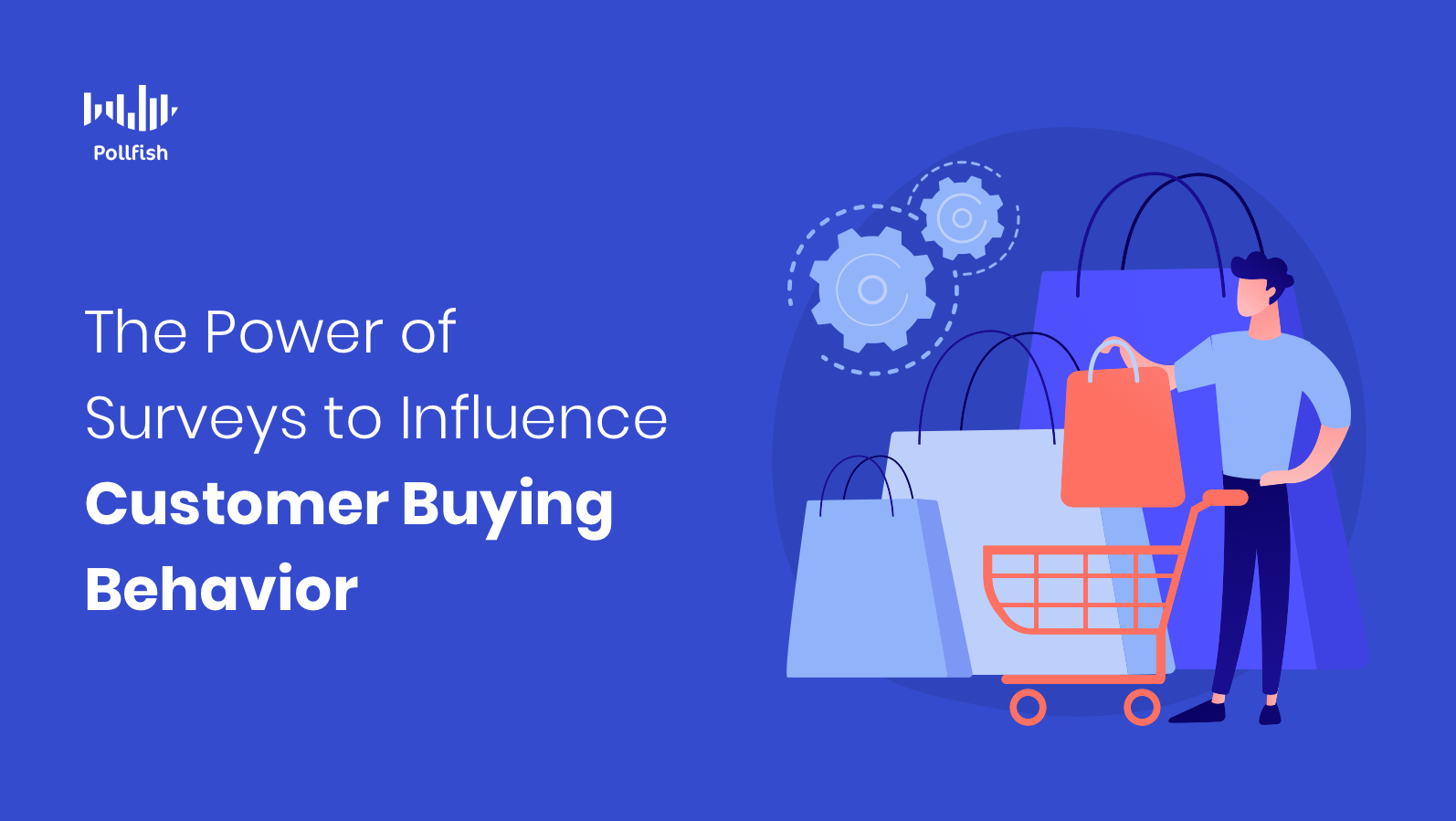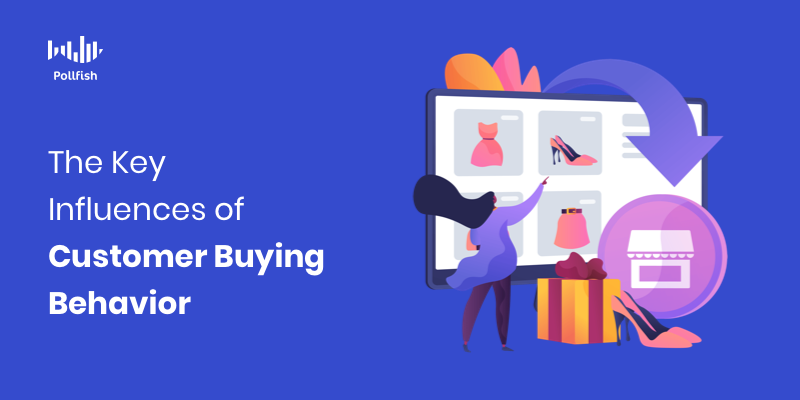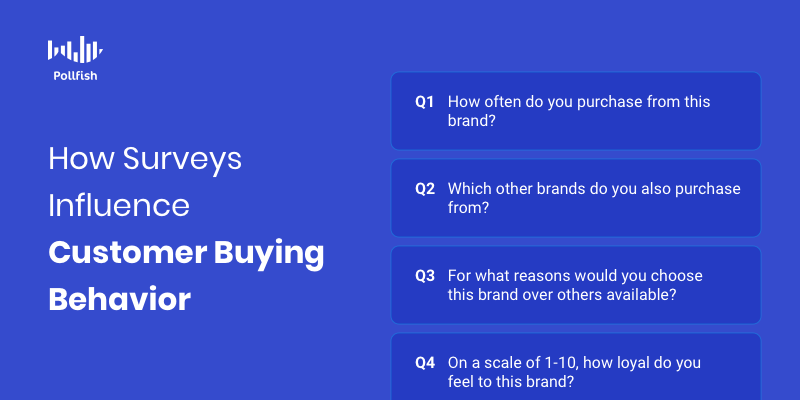How Surveys Influence Customer Buying Behavior

All businesses must examine their customer buying behavior in order to survive, not least if they seek to flourish. This is notably due to the direct effect this behavior has on patronage, such as sales, site visits, in-store visits, intent to purchase, customer loyalty and more.
Thus, all businesses ought to keep a close eye on their customers’ buying behaviors. There are a number of ways to do this. Market research techniques offer the most data-driven approach to understand these behaviors and a business’s target market at large.
Surveys, in particular, offer quick access into the minds of consumers, allowing businesses to study them at their whim and procure intelligence on their many facets, such as their sentiments, opinions and buying behavior.
But did you know, aside from studying customer buying behavior, surveys can also influence it? In this way, the surveys themselves act as marketing and advertising vehicles that allure customers to specific brands.
This article explores the concept of customer buying behavior, its importance, its four types and more, along with how surveys alone can influence it.
Understanding Customer Buying Behavior
As its name implies, this is a kind of customer behavior, one that is especially concerned with how customers buy, along with the actions and behaviors they take part in before purchasing.
Customer buying behavior refers to the ways in which a target market, the customers most likely to purchase from a business, acts when shopping for a product. Customer buying behavior takes into account the entire customer journey — from discovery, to nurturing, to browsing, to purchasing and possibly repurchasing.
This “behavior,” or rather, set of behaviors is shaped by personal and aided factors, along with external and environmental factors such as social climates, issues and occurrences. All of these play a role in driving customer perceptions of a brand, thereby driving their buying decisions, whether they are rational or irrational.
Buying behaviors take place both on and offline before customers make a purchase.
Given that customer buying behavior encompasses a wide breadth of interactions, such as searching for a product on a search engine and discovering a brand that sells it (SEO and SEM), engaging with a brand’s social media or reading marketing collateral, marketers have plenty of environments to observe their customer buying behaviors.
As such, marketers and market researchers study customer buying behavior to better produce marketing initiatives that influence customers to make purchases.
The Importance of Customer Buying Behavior for Businesses
This phenomenon is critical for businesses to study and especially to influence. When a brand has enough sway over its target market, it will generate more revenue, customer loyalty and a longer customer lifetime value (CLV).
When businesses fully grasp the customer buying behavior of their target market, they can intelligently conceive and carry out different marketing campaigns. In this way, understanding customer buying behavior not only guides marketing efforts, but helps avoid missteps, errors and wasting time and resources.
It is critical to examine buying behaviors, as they are not stagnant. Since the beginning of the pandemic, 48.7% of customers changed their buying behaviors, switching their purchasing preferences to the digital space. That is because they replaced products that they regularly bought at physical stores with competitors’ online shops.
Additionally, in the wake of COVID-19 click and collect sales grew in the US by 60.4%, attesting to the popularity of buying items on the internet, however merging internet purchases with physical pick-ups, that is, at a store or retail hub location. This comes as a rather
Customers also change their buying behaviors in terms of brand switching. This has been documented during the pandemic, as 36% of consumers tried a new product brand in the midst of COVID, while 25% of customers switched to a private-label brand.
73% of consumers who have switched brands will continue using their products regularly, which means that they will either use the new brands alongside the brands they’ve used before, or completely replace the old brands with the new one(s).
Thus, all businesses should expect their target market to either switch or try their competitors’ products and services at some point. In this way, studying and influencing customer buying behavior largely affects customer retention and loyalty.
When businesses have a solid understanding of their target market’s buying behaviors, they can produce messaging that is better targeted, thus resonating with certain market segments. This helps improve brand equity and will generally leave customers with a better impression of a business.
Additionally, it allows companies to understand when customers typically make purchases so that companies can target their messaging accordingly and reach consumers when they are most likely to shop. For example, some businesses may observe that customers buy during the weekends or on the evenings of weekday nights. Thus, it would be apt to incorporate a new sales banner or social post during those times.
All in all, paying heed to customer shopping behaviors helps businesses on several fronts.
The Key Influences on Customer Buying Behavior
As aforesaid, there are various factors at play when it comes to influencing customer buying behavior. First off, there are the external factors, such as current events, social and political issues and other emotionally evoking happenings.
In 2018, a Harvard professor reported that emotion is one of the biggest drivers of buying behaviors and decisions in general. Thus, brands ought to study their customers’ emotions, particularly their responses to current issues.
Some customer segments may be inclined to buy from socially responsible companies: companies with business models that focus on social change via philanthropic, charitable or activism-based activities. Others may have a buying behavior influenced by such companies.
But there will always be customers who gravitate towards a brand that supports a cause or idea that they too care about. Thus, it is crucial to understand the key influences of customer buying behavior.

Aside from the way companies present themselves in relation to external issues, there are three other key influences on customer buying. The three other key components are:
- Rational considerations of the product and service. These include:
- Price, quality, and convenience
- Mental or cognitive factors such as product utility and value
- Irrational considerations such as feelings and desires. These include:
- Emotional, aka affective factors such as irrational considerations, which include personal beliefs
- Behavioral aspects such as
- Buying patterns
- Preferences based on routines and habits
The 4 Main Types of Customer Buying Behaviors
When customers make purchases, their buying behaviors almost always fall into at least one of four categories. These categories classify a wide range of situations that can occur in similar ways based on the behavioral aspects of the scenarios.
The following explains the four main types of customer buying behaviors:
- Complex buying behavior
- The most typical buying behavior
- This usually occurs when buyers make big purchases, such as a new vehicle or real estate.
- This type of behavior includes a high level of research and prudence before choosing a product.
- As such, this kind of behavior involves long considerations before customers make any purchase.
- This behavior stems from an instance in which a purchase will have a significant impact on a customer’s life, especially when the purchase involves risks.
- Habitual buying behavior
- This refers to customers who buy the same product repeatedly.
- Such customers manifest a high level of product loyalty.
- This involves brand loyalty, such as buying from the same bread company during each shopping trip or online visit.
- Consumers who engage in habitual buying rarely research alternative products of brands.
- They don’t look for similar brands or products as they are used to buying a particular kind (or kinds). Thus, they exhibit the most customer loyalty.
- Variety seeking buying behavior
- This behavior stands in opposition to habitual buying behavior.
- Consumers with this buying behavior look for variety because they have yet to find their favorite product.
- This kind of behavior takes shape when customers seek novelty in their would-be, go-to products.
- For example, when customers try different hair-dying brands before settling on one.
- Customers with this buying behavior carry little to no brand loyalty.
- Dissonance reducing buying behavior
- This occurs when customers are afraid to make the wrong buying decisions.
- This behavior stems from a fear of buyer’s remorse.
- It is especially prevalent in situations where customers cannot return items should they not be satisfied, or when returning products is too difficult, such as in the case of a faraway store or expensive return shipping.
- This behavior comes about when customers’ have a bad past experience with a particular product.
- This often occurs when customers spend more time comparing different aspects of a product rather than comparing different product brands.
How Surveys Influence Customer Buying Behavior
Although there are many ways businesses can study customer buying behavior, they can also take part in activities that influence their customers’ buying habits. There is also a means that offers businesses with a twofold prowess: being able to study customer buying actions and influence customer behavior as well.
The solution that offers this dual prowess is a market research survey. Surveys give businesses and market researchers access into the minds of their target market. There is a vast amount of surveys and broader survey research methods.
Businesses can run survey campaigns for all 6 of the main types of research. As such, businesses can probe their customers’ buying behaviors by deploying surveys to their target market online. They can also send surveys to specific segments of their target market.
Surveys have the ability to reveal major aspects of consumer opinions and sentiments, thereby allowing businesses to examine their buying behaviors. This is because surveys allow businesses to ask their respondents virtually anything, allowing them to better deliver their marketing messaging, images, advertising and other campaigns.
Thus, by studying customer behavior through surveys, businesses can make more informed decisions, the kind that can allow them to produce more effective marketing campaigns.
However, since surveys offer a dual power, their ability also extends to influencing customer buying.

Several years ago, Harvard ran a study to discover how surveys can affect customer behavior. The results of the survey study bear good news for businesses; as it turned out, customers that were surveyed were more than as likely to open new accounts with businesses.
In addition, this study discovered that the customers who were surveyed were less than half as likely to renege on their patronage and were even more profitable than the customers who weren’t surveyed.
This study reveals that surveys have the power to present a brand in a positive light, or at the very least, bring brand awareness to a brand that target customers may otherwise not have heard of.
Thus, businesses that wish to influence their customers’ purchasing behaviors ought to conduct surveys. They must bear in mind that in order to influence their customers via surveying them, the surveys must mention the business by name. Companies must paint their brands in as positive a light as they possibly can. This includes making light of the fact that they support causes that their customers care about.
The more surveys that businesses run to study buying behaviors, the better they can present themselves in upcoming surveys to influence their customers.
Creating the Strongest Behavioral-Influencing Campaigns
Surveys are an excellent approach to reaping intelligence on customer buying behavior, as well as influencing this behavior. However, in order to maximize both efforts, businesses must use the proper online survey platform.
All online survey tools are not built with the same dashboards, capabilities and interfaces. Thus, market researchers should research the available online survey software before deciding on one platform to run all of their market research campaigns.
Given that these platforms offer a primary means of research, they must be chosen carefully. The most convenient online survey platforms will offer various capabilities, ease of use, deployment across a wide network of digital properties, including websites and apps, along with artificial intelligence and machine learning to stave off faulty answers and poor data quality.
Moreover, such a platform should offer global support, so that businesses can rely on experts to guide them with their surveys at any point of the day. A survey platform of this caliber will make it easy to both examine and influence buying behaviors.
Pollfish Marketing Team
Ready to Try Pollfish?
Create your survey with AI, target high-quality respondents starting at $0.95 per complete, and start getting results in just minutes in real-time. From running a simple product concept survey to managing a constant stream of trackers for dozens of clients in dozens of countries, we’ve got you.
